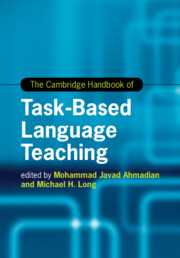Book contents
- The Cambridge Handbook of Task-Based Language Teaching
- Cambridge Handbooks In Language And Linguistics
- The Cambridge Handbook of Task-Based Language Teaching
- Copyright page
- Dedication
- Contents
- Figures
- Tables
- Contributors
- Preface The Origins and Growth of Task-Based Language Teaching
- Part I The Rationale for Task-Based Language Teaching
- Part II Tasks and Needs Analysis
- Part III The Task Syllabus and Materials
- Part IV Methodology and Pedagogy
- 9 A Psycholinguistically Motivated Methodology for Task-Based Language Teaching
- 10 Technology-Mediated Task-Based Language Teaching
- 10A Delivering Task-Based Language Teaching at Scale
- 10B Task-Based Language Teaching and Indigenous Language Revitalisation
- 10C Task-Based Simulations for Diplomatic Security Agents
- Part V Task-Based Language Teaching with School-Age Children
- Part VI The Teacher in Task-Based Language Teaching
- Part VII Task-Based Assessment and Program Evaluation
- Part VIII Research Needs and Future Prospects
- Index
- References
9 - A Psycholinguistically Motivated Methodology for Task-Based Language Teaching
from Part IV - Methodology and Pedagogy
Published online by Cambridge University Press: 19 November 2021
- The Cambridge Handbook of Task-Based Language Teaching
- Cambridge Handbooks In Language And Linguistics
- The Cambridge Handbook of Task-Based Language Teaching
- Copyright page
- Dedication
- Contents
- Figures
- Tables
- Contributors
- Preface The Origins and Growth of Task-Based Language Teaching
- Part I The Rationale for Task-Based Language Teaching
- Part II Tasks and Needs Analysis
- Part III The Task Syllabus and Materials
- Part IV Methodology and Pedagogy
- 9 A Psycholinguistically Motivated Methodology for Task-Based Language Teaching
- 10 Technology-Mediated Task-Based Language Teaching
- 10A Delivering Task-Based Language Teaching at Scale
- 10B Task-Based Language Teaching and Indigenous Language Revitalisation
- 10C Task-Based Simulations for Diplomatic Security Agents
- Part V Task-Based Language Teaching with School-Age Children
- Part VI The Teacher in Task-Based Language Teaching
- Part VII Task-Based Assessment and Program Evaluation
- Part VIII Research Needs and Future Prospects
- Index
- References
Summary
Task-based language teaching (TBLT) methodology is theoretically and empirically motivated. It is rooted in in cognitive and interactionist second language acquisition theory and based on inferences from research findings that show how learners acquire an second language. As a result, TBLT is able to create a psycholinguistically optimal environment for second language learning by taking into account the main factors that contribute to the sedond language learning process and that make seond language teaching more efficient. This chapter summarizes the theoretical underpinnings of TBLT methodology and provides a review of major research findings on variables in instructed second language learning that have been identified as having a relevant impact on second language learning: attention to form, negative feedback, and cognitive individual differences. The chapter concludes by discussing the implications of the research findings presented for a psycholinguistically defensible methodology for TBLT and the problems these findings pose for traditional options in language teaching, such as the structural syllabus.
Keywords
- Type
- Chapter
- Information
- The Cambridge Handbook of Task-Based Language Teaching , pp. 305 - 325Publisher: Cambridge University PressPrint publication year: 2021
References
Further Reading
References
- 1
- Cited by

